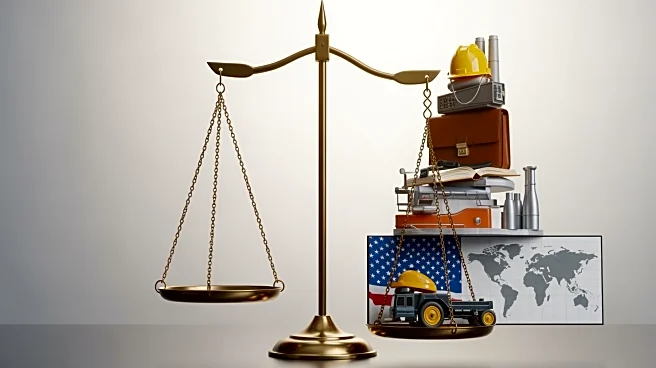What's Happening?
The Supreme Court is currently reviewing the legality of President Trump's extensive tariffs, which have been in place for over seven months. These tariffs, imposed on goods from nearly every country,
have contributed to rising prices for imported items such as coffee, clothing, and furniture. According to Erica York from the Tax Foundation, only about 20% of the tariff burden has been reflected in retail prices so far, as companies initially relied on stockpiles and delayed price changes due to uncertainty around tariff rates. However, businesses are now beginning to pass these higher costs onto consumers, which economists predict will become more common in the coming months. The Tax Foundation estimates that if tariffs persist, the average household could face an additional financial burden of $1,600 next year.
Why It's Important?
The tariffs have significant implications for the U.S. economy, affecting consumer prices and potentially influencing voter sentiment, as seen in recent elections where the cost of living was a major concern. While the Treasury Department has seen increased revenue from tariffs, the impact on American products is mixed, with domestic goods experiencing price increases due to higher demand. The Supreme Court's decision on the legality of these tariffs could drastically alter the economic landscape, potentially reducing the average household's financial burden if deemed illegal. However, even if the court rules against the tariffs, President Trump may still have alternative methods to impose them, maintaining economic uncertainty.
What's Next?
The Supreme Court's forthcoming decision will be pivotal in determining the future of President Trump's tariff policy. If the tariffs are ruled illegal, households could see a reduction in their annual financial burden, dropping from an estimated $1,600 to $400. This decision could also influence broader economic strategies and political dynamics, as tariffs have been a contentious issue affecting voter preferences and economic stability. Businesses and consumers alike are closely monitoring the situation, anticipating potential changes in pricing and market conditions.
Beyond the Headlines
The ongoing debate over tariffs highlights deeper economic and political tensions, including the balance between protecting domestic industries and managing international trade relations. The tariffs have sparked discussions about the president's authority to impose such measures and the broader implications for U.S. trade policy. As the Supreme Court deliberates, the outcome could set a precedent for future administrations, influencing how trade policies are crafted and implemented.












